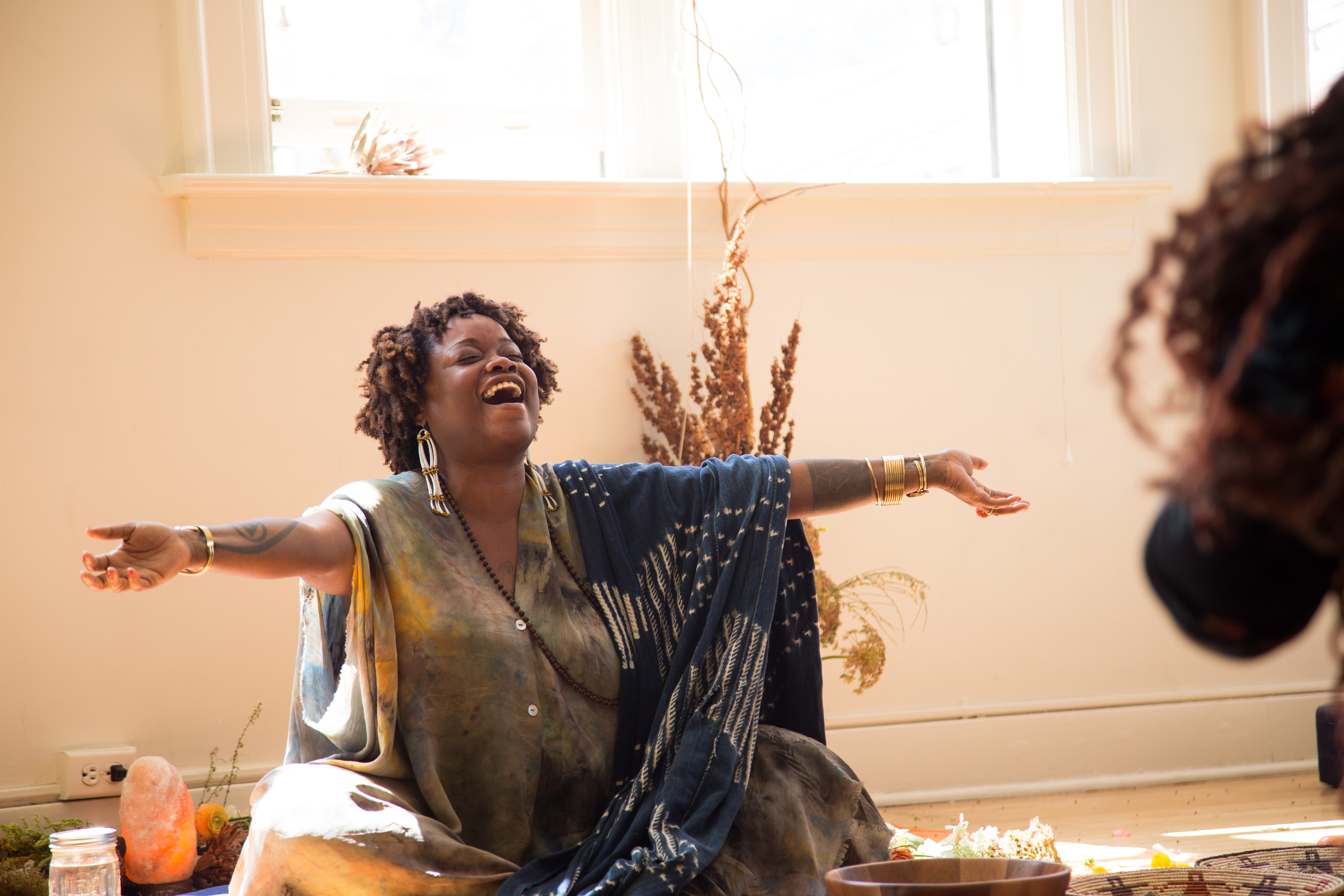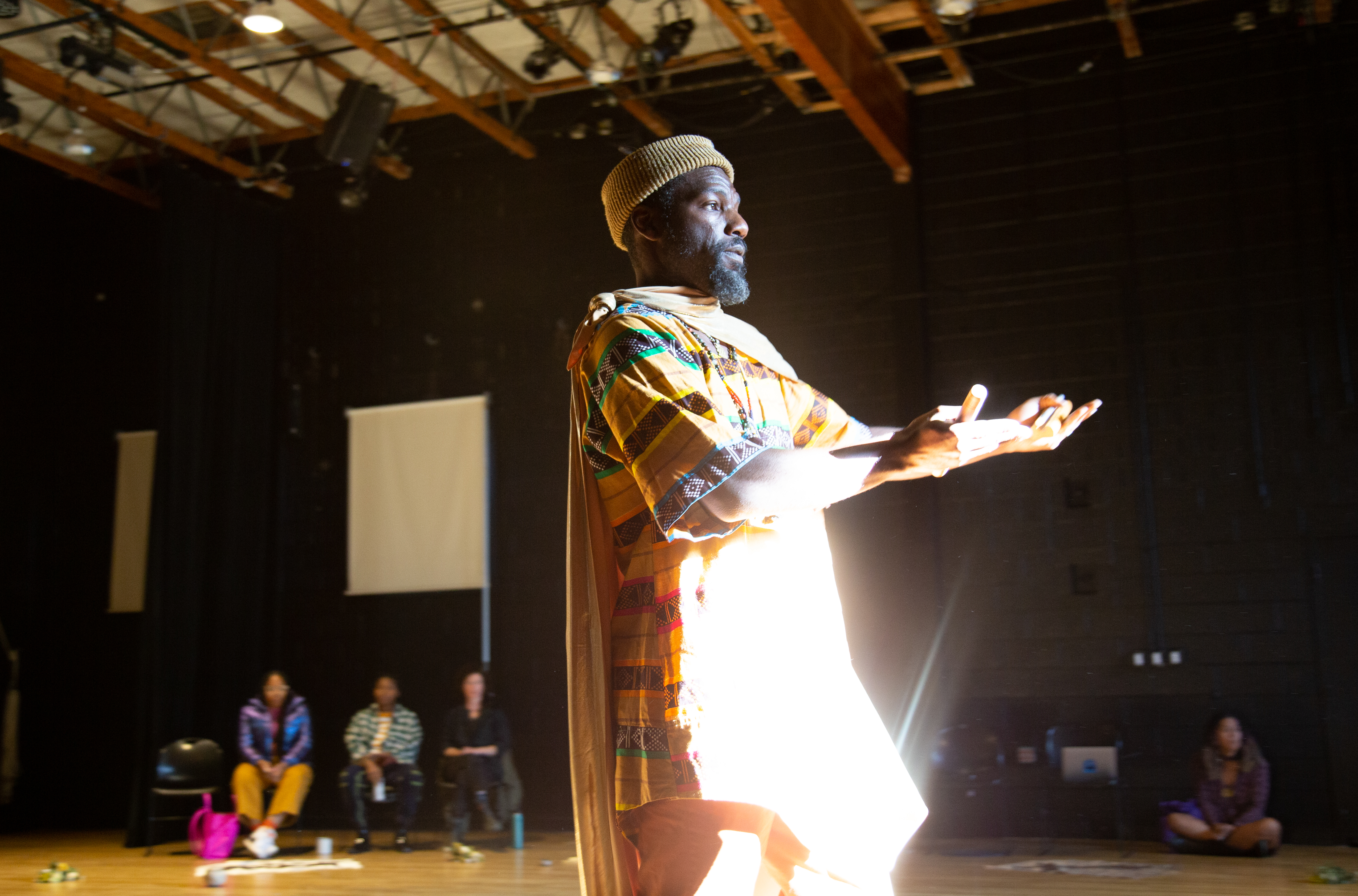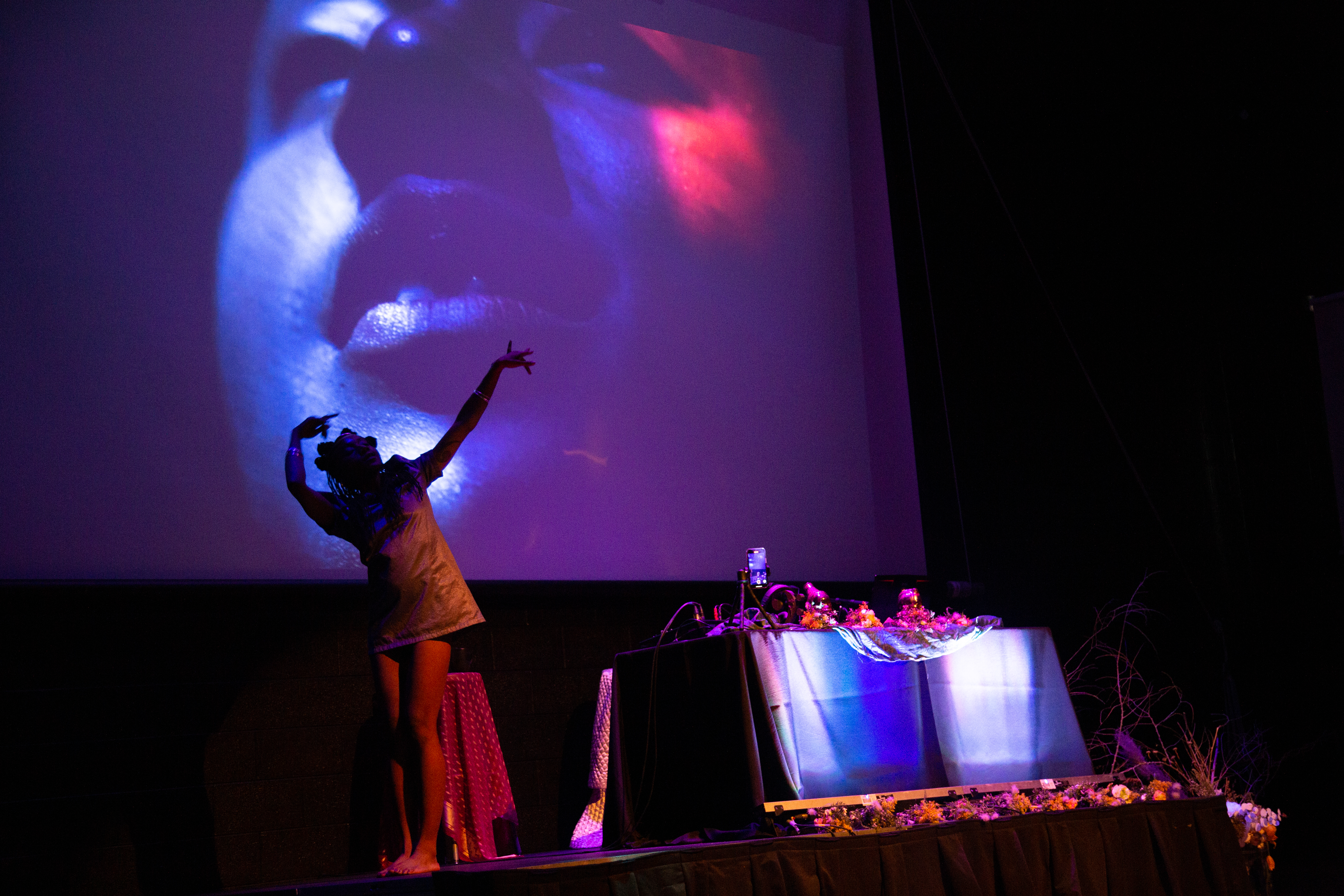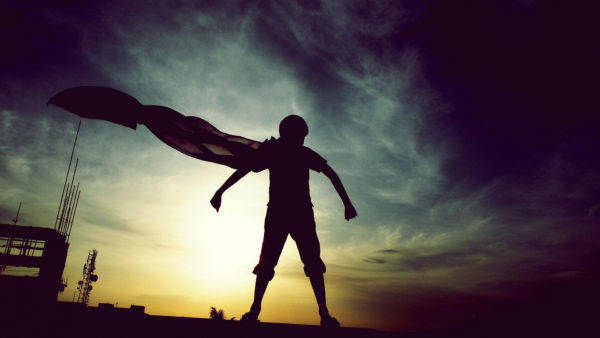Cosmic Identities and Mythic Intersectionality- Reflections on Afrofuturist Ritual and Alter-Temporalities
In April of 2022, in conjunction with an alignment of Jupiter and Neptune, Naropa University hosted the Dreaming For Our Lives- Afrofuturist and Astrological Pop- Up Festival. The festival brought poets, healers, astrologers, artists, educators, students and community into a four day journey into liminal time, culture and creativity, with the expressed intention of sensing into new/alter futures from the level of the imagination. While it centered Black creatives, facilitators, wisdom traditions, and cultural references, it was open to people across the melanin spectrum. What emerged was a collaborative journey and a temporary community, unfolding in ways unexpected and nourishing to those who attended.
One of the key purposes of this festival and perhaps the Afrofuturist/Black Futures movement is to open to new/alter ways of being, feeling and acting: to be able to perform facets of our identities and our selves that are relegated to the realms of science fiction, fantasy or idleness in the order of the everyday.
Dreaming for Our Lives was a chance to collectively enter into our cosmic identities or mythic intersectionalities. I will mix and match these two phrases and use them interchangeably, in a sense more evocative than technical here. Since legal and racial justice scholar Kimberly Crenshaw coined the term intersectionality in the late 1980’s to designate individuals who belonged to two distinct legally protected groups at once, oftentimes with competing claims, intersectionality has exploded into a household name. As often happens when ideas become popular, it has been morphed at times beyond its original definition. Intersectionality identifies the ways that we must navigate distinct but overlapping types of oppression, often simultaneously. It also indicates that we may be part of privileged and marginalized groups at the same time/in one body. This became the basis for intersectional feminism, which brought intersectionality to next level not only as a legal category or conceptual mode of understanding, but as a means to build movements and develop allyship between people of varied identities and social locations. Recently authors like Reverend angel Kyodo williams have discussed intersectionality as a kind of interconnectedness, or even interbeing. Intersectionality can illuminate how we are woven with one another, and how our traumas and strategies for survival are shared, or how they might be shared. Intersectionality reveals our embeddedness, not only in particular socially defined identities, but in the flow of human history.
In addition to ascribed or chosen identities like race/skin color, gender, sexuality, ability, social class, nationality and so forth, we also develop a sense of identity out of our experiences with the liminal. Typically intersectionality is discussed with strictly human, legalistic contexts of socio-political power and historical relationship. It usually deals with identities that are assigned externally, that are political projects and carry attendant levels of access and danger. Frequently what is not discussed is the way that we develop identity outside of not only dominant discourses, but outside of dominant realties and ontologies. Our identity can be shaped or transformed in the natural world and in the depth of the imagination, meditation, or what is historically called soul. Often in anti-oppression and justice spaces, a kind of constraint develops. We can never step outside of the structures of power and language set up by a particular society. We sometimes force ourselves into a kind of two-dimensional flat world where no one can move, and shifting the systems begins to seem impossible. Cosmic and mythic intersectionality presupposes that there is both a horizontal space of our assigned and ascribed social identities, and an inner or vertical space for identity creation. We also constellate selves, sometimes multiple, around our experiences in liminal times/spaces or the natural world, in the arts, in contemplation, mediation, dance, prayer and psychedelic experiences that melt down our sense of human centeredness and take us beyond the limitations of a particular historical moment. Our mythic identities develop in response to non- ordinary states of consciousness. They are identities where our humanness fuses with particular environments, with vegetation, animals, bodies of water, star constellations and planets, with descendants, ancestor or culture heroes, with elements and dynamics of nature, technology and other works of human artifice, with physical energies and spiritual forces. In our cosmic intersections we know ourselves to be more than the children of a particular culture, family and moment in history. We know ourselves to be children of infinity.
Herein lies the possibilities of post-traumatic growth, or the transmutation of trauma into sacred wounds. Here lies the transposition of cultural-political struggles against oppression into the mythic and timeless, the alchemizing of fear and brutality into love and wisdom. Cyberfeminist Donna Haraway spoke of the imagination as one of the poles of historical transformation, the other being the material. Afrofuturism is an intervention in the social and material by way of ancient and fresh imaginations. Afrofuturism asks black peoples and all that want liberation from our current genocidal social script to meet at the crossroads between the present, past(s) and possible futures or to step one foot out of time altogether. Although our mythic identities and cosmic intersectionalities are not completely bound by spatial-temporal social locations and historical power dynamics, they are also not completely free or unaffected by them. Building on our typical understandings of intersectionality, the textures of experiences and challenges will differ if one inhabits a body that is read as a black and male than a body that is read as black and female, or black and queer. So too our cosmic identities touch history, alter and are altered by their interaction with our other social locations. For that reason it is often important that we source our mythic identities from cultural traditions that our peoples have some experience and resonance with – or at least have some knowledge or acquaintance with them. Afrofuturism works specifically to revive/rewrite cultural archetypes that come out of the diasporic/dystopian experience of black people as well as the indigenous, traditional, urban and emergent cultures of continental Africa, its wisdom traditions, works of art, music and so forth.
Through the medium of popular culture, this society provides a host of mythic character types (often emptied of soul force) who are both connected to particular cultures and in some ways transcendent of them. Witness your fairies, mermaids, werewolves, superheroes and so forth. If you can accept that these popular tropes have at least one foot in the archetypal realm, we can see one example of the importance and the ways that our cosmic identities are tinctured by our earthly identities. Let’s take a peak at the goth subculture for example. One powerful cultural archetype being played out by those that identify with this subculture is that of the vampire. You can see the way that the vampire idea expresses itself in dress, makeup, posture and poise, modes of speech or times of day you might see some goth folks. Recently there has been a rise in a black/african american goth scene, eyebrow raising because typically goth culture is identified as a “white” subculture. The fact that black goths are rare or perceived that way demonstrates how our horizontal social locations interact with our more vertical, imaginative and mythic identities.
An important point of consideration as well is the way that mythic identities buffer and shore up our temporal and earthy identities. One key concern raised by Afrofuturists concerns representation in sci-fi and fantasy media. If black and brown people are fed mythic stories that only feature white people, or further portray characters of color as synonymous with evil or degeneracy, what impact does that have on our psyche and our navigation in the everyday world?Intersectionally we can ask what happens to the psyche and social expectations of queer folks if “the future” only features hetronormative models of relationship? Furthermore, what messages do individuals in “dominant” racial and gendered identities internalize when stories of the future or mythic past only feature those that share their social locations?
We can also extend these questions to the built environment. If the architecture of your living space sources all of its mythic references come from one cultural tradition, one that is not only not your own, but historically hostile to your existence, what does this do to one’s sense of being at home in the place where you live? Witness the neoclassical style and Greco-Roman hang-overs in our civic capitals and downtown metropolitan areas. We might consider this final question in light of the insurrections in the spring and summer of 2020, where both real and symbolic centers of power were defaced and removed. Westeros is not real, Numenor is not real, but they do have a real impact on the sense of historical and imaginative richness (and limitation/distortion) of their viewers, particularly of European descent.
The efficacy of mythic intersectionality shows up in another way as well. In counter-cultural and new age spaces we often see white individuals who play out mythic identities such as channeled entities that claim otherworldly or universal origins/relevance. While many of these communications offer fresh and stimulating imaginations, they are also culturally shaped in their expression by the whiteness of their “hosts”, in ways that are unacknowledged. Witness the blonde haired blue eyed Pleiadians. Why shouldn’t they be blue, or purple, with kinky hair? The point is not to try to eliminate this cultural “coloring” of the liminal (white as a color, as a “distortion” of the real), but to be awake to its influence, impact and importance.
The well of stories and myth that we have to draw from help to frame and support our “real” and existing identities. To take this one step further in anti-oppression and critical discourses it is widely recognized that identity is not a given, rather our identities are enforced, socially constructed and most importantly here performed. This is a key remembrance in the discussion of mythic and cosmic identities.
In Afrofuturist spaces going back/forward since Sun Ra we have blackness as the alien, the other, the extra-terrestrial. Ra suggested that since mainstream white society looked at black people as non-existent, or as fantastic beasts, that black people take up that space as a position of strength and actively develop those qualities and practices that could help us do other and escape the compulsive and destructive ways of societies based on white supremacy and an apocalyptic linearity. Black people could live in the blackness of space, which was not only outside of the earth, but all around us and infinite inside of us as well. Recent Afrofuturists such as Janelle Monae have taken on the mythic identity of the android as a social location of resistance and alter/altar imagination. The android as portrayed by Monae is as a being with a flat, if cheerful affect, hyper-beautiful, hyper-symmetrical, and a blank humanoid form free to be projected upon and programmed but also free of personal and historical bias, with lucid perception of situations, and fearlessness/non-attachment to naming them for what they are. For diasporic Africans, whose native tongues have been erased, any cultural retrieval will inevitably involve or be an act of imagination. In mainstream society we play out cultural characters or (arche)types. Anyone can put on a costume on Halloween and be a generic Superman. But as we spend more time communing with these identities and the cultural and psychic forces that create them, we can develop individualized versions of them, cosmic identities that reflect our specific visionary and ecstatic experiences, our particular longings, traumas, wounds, the histories of our families and peoples, and our specific sense of mission, purpose and vocation. We can develop identities that externally reflect the lives of our individual and collective soul.
These are some examples of how mythic intersectionality plays out, more suggestive rather than exhaustive. Across the world and time people have sought to make space for their mythic intersectionalities and cosmic identities in ritual, ceremony, theater, solitude, celebration and other ludic and liminal/limonoid spaces. Where in our society do we make space for the play of imagination, or further for the active embodiment and intersubjective socializing of the imagination? And where can we do so without them becoming commodities or commodifying others? If there is no place to practice, to step into our soul characters and play them out, to live them, do they atrophy? Do the particular rainbow bridges to infinity that they represent begin to fade, dissipate and crumble? If we do not play out these higher and more multi-dimensional selves to one another do we lose track of them, and thus become unmoored in space and time? In our ancestral traditions the world over the resounding response is yes!
To maintain these connections, our ancestors assigned times of day, in the lunar month, solar year, in greater cycles concerning other heavenly bodies, and in cultural calendars to move into the liminal, to a make space when the more than human could come into the human community and help heal, refresh and make new the life of individuals and society.
In traditional African cultures many rituals revolve around elaborate masking traditions. The creator of the mask and those wearing them in ceremony both know that they are fashioning and performing the presence of a god. They are making an appearance of a god in the life of the village. These masks are not used casually, and are often hidden away prior to and after a ceremony to ensure that their magical effects have both the most impact when needed and do not run rampant. As we “put on” or perform our mythic identities, the mask is useful as metaphor and more. These identities (all of them?) can to various degrees be put on and taken off, or perhaps merely hidden (passing as human). In post-modern contexts we can also recognize that our concepts and cultural conditioning (though deep) are not the totality of who we are, and that we can shapeshift and change identities and ideas as we change contexts, or that we can host multiple identities at once or sequentially/circumstantially. We can code switch between ontologies. If we introduce the vertical dimension of the soul or transpersonal, we come to see that even the body, feelings and conceptual mind can be masks, worn by our souls to interact in the material “horizontal “ dimension. I invite our movements to take up our cosmic intersections and mythic identities, as evocative phrases and deed. We are more than what history and power have made us. We can socially construct the material out of the ethereal.
Dreaming For Our Lives invited us to play and perform cosmic intersectionalities, to bring mythic identities to the fore, to walk like them, feel and see like them, and imagine/co-create the worlds that they would inhabit. It invited us to use the power of the word- of nommo, of music and movement, of color, costume, of face paint, wild hats, of a deep attunement to our somatic selves and a deep attunement to our capacities to grieve and enjoy- as acts of masking. We enlisted astrology here as a repository of shared characters, as a hall of masks, historical personages and ancient faces, as an imaginal ring of mythic and cosmic intersectionalities to draw from and enrich both our interpersonal experiences and sense of time. We dreamed publicly, in three (four, five) dimensions. We dreamed in objective social space and attempted to seed new timelines and worlds, with different rhythms and purposes than the everyday and dominant. It was an endeavor to yoke ourselves to the stars, to the water, to our blackness, to one another and to a co-created futures where we all thrive: where we are not bound by the distorted dreams of supremacy, but where each of us is a creative center, prisming rainbows of intelligence and feeling though our embodied identities in ecstatic conversation. Each of us as a star, linking with others to create constellations to guide the present, heal the past, and divine shared tomorrows.










You must be logged in to post a comment.